Kristian Schultz
Preserving logical and functional dependencies in synthetic tabular data
Sep 26, 2024



Abstract:Dependencies among attributes are a common aspect of tabular data. However, whether existing tabular data generation algorithms preserve these dependencies while generating synthetic data is yet to be explored. In addition to the existing notion of functional dependencies, we introduce the notion of logical dependencies among the attributes in this article. Moreover, we provide a measure to quantify logical dependencies among attributes in tabular data. Utilizing this measure, we compare several state-of-the-art synthetic data generation algorithms and test their capability to preserve logical and functional dependencies on several publicly available datasets. We demonstrate that currently available synthetic tabular data generation algorithms do not fully preserve functional dependencies when they generate synthetic datasets. In addition, we also showed that some tabular synthetic data generation models can preserve inter-attribute logical dependencies. Our review and comparison of the state-of-the-art reveal research needs and opportunities to develop task-specific synthetic tabular data generation models.
Convex space learning for tabular synthetic data generation
Jul 13, 2024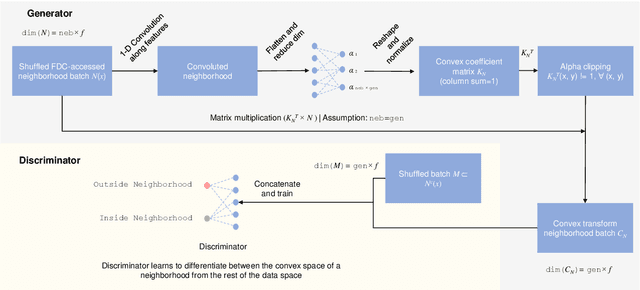

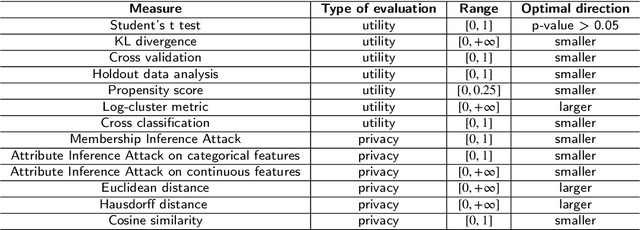
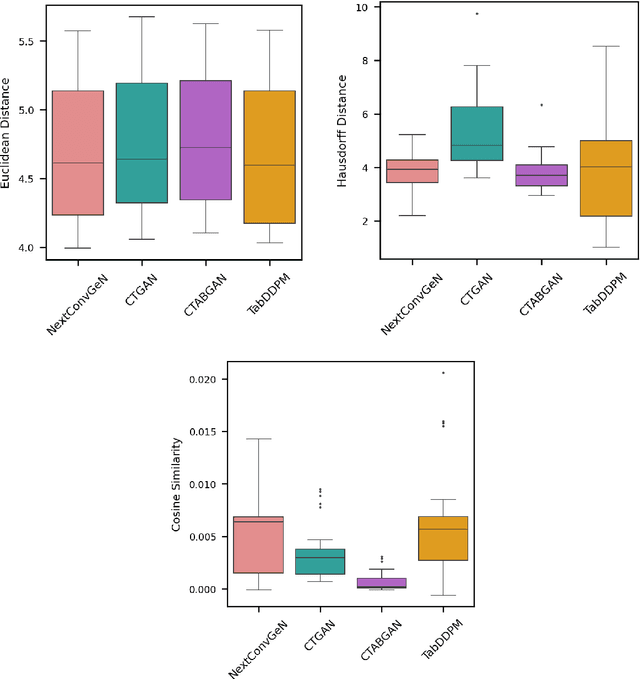
Abstract:Generating synthetic samples from the convex space of the minority class is a popular oversampling approach for imbalanced classification problems. Recently, deep-learning approaches have been successfully applied to modeling the convex space of minority samples. Beyond oversampling, learning the convex space of neighborhoods in training data has not been used to generate entire tabular datasets. In this paper, we introduce a deep learning architecture (NextConvGeN) with a generator and discriminator component that can generate synthetic samples by learning to model the convex space of tabular data. The generator takes data neighborhoods as input and creates synthetic samples within the convex space of that neighborhood. Thereafter, the discriminator tries to classify these synthetic samples against a randomly sampled batch of data from the rest of the data space. We compared our proposed model with five state-of-the-art tabular generative models across ten publicly available datasets from the biomedical domain. Our analysis reveals that synthetic samples generated by NextConvGeN can better preserve classification and clustering performance across real and synthetic data than other synthetic data generation models. Synthetic data generation by deep learning of the convex space produces high scores for popular utility measures. We further compared how diverse synthetic data generation strategies perform in the privacy-utility spectrum and produced critical arguments on the necessity of high utility models. Our research on deep learning of the convex space of tabular data opens up opportunities in clinical research, machine learning model development, decision support systems, and clinical data sharing.
Convex space learning improves deep-generative oversampling for tabular imbalanced classification on smaller datasets
Jun 20, 2022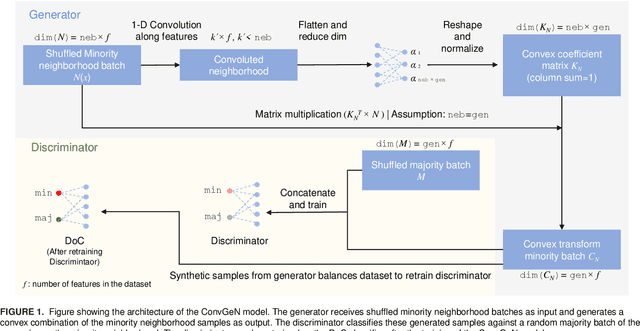


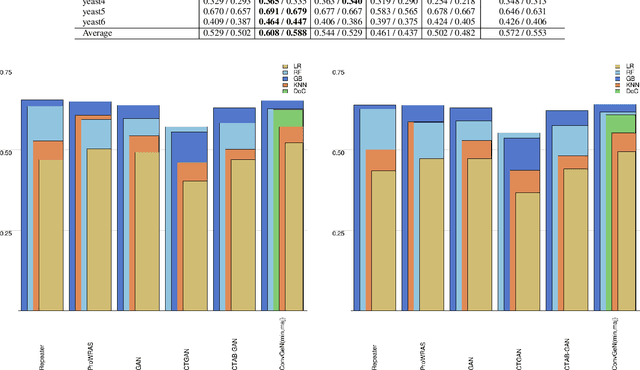
Abstract:Data is commonly stored in tabular format. Several fields of research (e.g., biomedical, fault/fraud detection), are prone to small imbalanced tabular data. Supervised Machine Learning on such data is often difficult due to class imbalance, adding further to the challenge. Synthetic data generation i.e. oversampling is a common remedy used to improve classifier performance. State-of-the-art linear interpolation approaches, such as LoRAS and ProWRAS can be used to generate synthetic samples from the convex space of the minority class to improve classifier performance in such cases. Generative Adversarial Networks (GANs) are common deep learning approaches for synthetic sample generation. Although GANs are widely used for synthetic image generation, their scope on tabular data in the context of imbalanced classification is not adequately explored. In this article, we show that existing deep generative models perform poorly compared to linear interpolation approaches generating synthetic samples from the convex space of the minority class, for imbalanced classification problems on tabular datasets of small size. We propose a deep generative model, ConvGeN combining the idea of convex space learning and deep generative models. ConVGeN learns the coefficients for the convex combinations of the minority class samples, such that the synthetic data is distinct enough from the majority class. We demonstrate that our proposed model ConvGeN improves imbalanced classification on such small datasets, as compared to existing deep generative models while being at par with the existing linear interpolation approaches. Moreover, we discuss how our model can be used for synthetic tabular data generation in general, even outside the scope of data imbalance, and thus, improves the overall applicability of convex space learning.
A multi-schematic classifier-independent oversampling approach for imbalanced datasets
Jul 15, 2021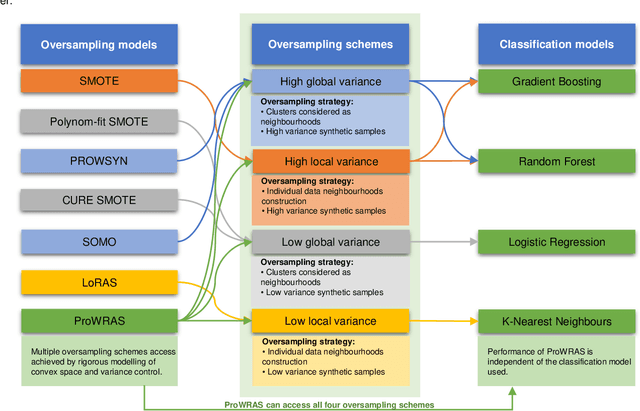
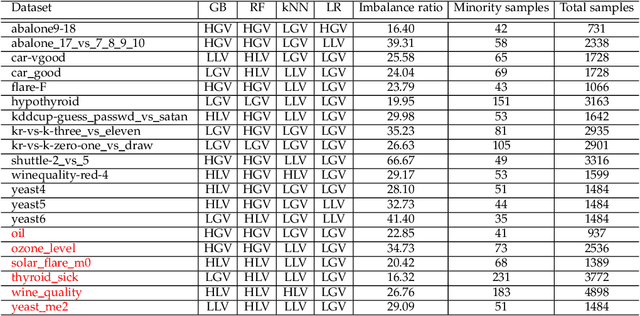
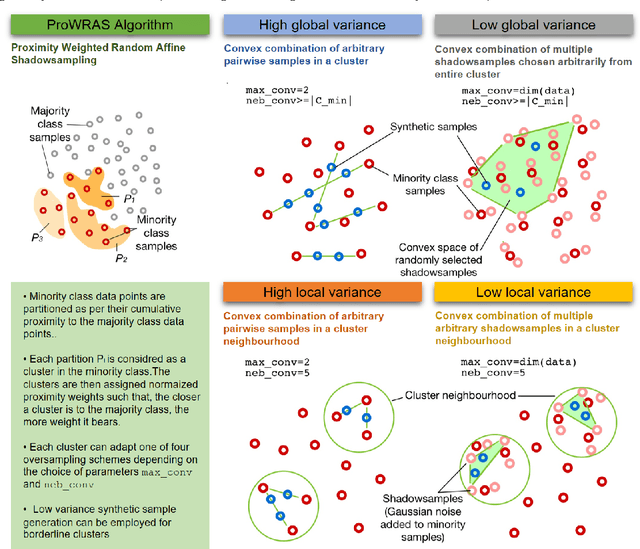
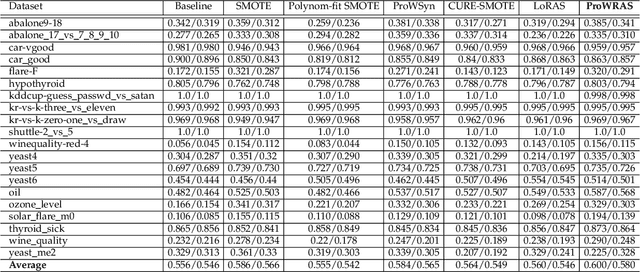
Abstract:Over 85 oversampling algorithms, mostly extensions of the SMOTE algorithm, have been built over the past two decades, to solve the problem of imbalanced datasets. However, it has been evident from previous studies that different oversampling algorithms have different degrees of efficiency with different classifiers. With numerous algorithms available, it is difficult to decide on an oversampling algorithm for a chosen classifier. Here, we overcome this problem with a multi-schematic and classifier-independent oversampling approach: ProWRAS(Proximity Weighted Random Affine Shadowsampling). ProWRAS integrates the Localized Random Affine Shadowsampling (LoRAS)algorithm and the Proximity Weighted Synthetic oversampling (ProWSyn) algorithm. By controlling the variance of the synthetic samples, as well as a proximity-weighted clustering system of the minority classdata, the ProWRAS algorithm improves performance, compared to algorithms that generate synthetic samples through modelling high dimensional convex spaces of the minority class. ProWRAS has four oversampling schemes, each of which has its unique way to model the variance of the generated data. Most importantly, the performance of ProWRAS with proper choice of oversampling schemes, is independent of the classifier used. We have benchmarked our newly developed ProWRAS algorithm against five sate-of-the-art oversampling models and four different classifiers on 20 publicly available datasets. ProWRAS outperforms other oversampling algorithms in a statistically significant way, in terms of both F1-score and Kappa-score. Moreover, we have introduced a novel measure for classifier independence I-score, and showed quantitatively that ProWRAS performs better, independent of the classifier used. In practice, ProWRAS customizes synthetic sample generation according to a classifier of choice and thereby reduces benchmarking efforts.
 Add to Chrome
Add to Chrome Add to Firefox
Add to Firefox Add to Edge
Add to Edge